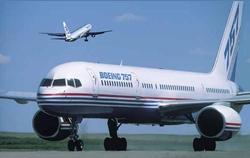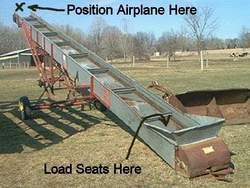Seats, Hay -- They've Each Gotta Go Upstairs
 In the spring of 2001, Larry Larson
and his colleague, Bob Harms, who help build Boeing 757s in a
factory near Seattle, let an old concept do what it was designed to
do -- lift 100-pound loads, all day. The old use for the machine
was to lift hay bales; the engineers found that it would lift
airplane seats just as well.
In the spring of 2001, Larry Larson
and his colleague, Bob Harms, who help build Boeing 757s in a
factory near Seattle, let an old concept do what it was designed to
do -- lift 100-pound loads, all day. The old use for the machine
was to lift hay bales; the engineers found that it would lift
airplane seats just as well.
The two men are part of a factory team called the "Moonshine
Shop" at Boeing, which is charged with discovering new ways to
decrease the costs and time required to build Boeing jetliners.
[Boeing says, "The Moonshine Shop gets its name from a Japanese
lean manufacturing philosophy where innovators develop new methods
in clandestine -- by the light of the moon late at night." OK,
sure, whatever --ed.]
That spring, the two colleagues had set off on a mission: find a
simpler way to lift heavy parts and assemblies, especially
passenger seats, from the factory floor to the airplane door. The
pair went looking for existing machines they could adapt for that
task.
 Some ideas were
immediately set aside (right).
Some ideas were
immediately set aside (right).
"We stopped at a carnival and watched the way Ferris wheel seats
move upwards," said Larson. "We looked at ski lifts and considered
roofing material loaders. We went to see how sugar beets are
loaded, and then we started looking at farm equipment."
Larson, who lives in rural Washington, had seen hay elevators
(also called hay loaders) in operation on neighboring farms --
lifting individual hay bales up into barn lofts. He knew the
elevators had potential for other uses and began visiting farm
equipment dealers and scrap yards to see what was available.
"We saw a lot of hay elevators both new and used," reported
Larson. "They were lightweight, easy to move, had a proven track
record and could lift 125-pound bales of hay up into barns. They
were very simple to modify, too."
The quest for the right one that could be modified to lift
airplane parts eventually led to the Level Best Ranch, a hay farm
that is a two-hour automobile ride east and over the Cascade
Mountains from Seattle, and to Jack Wheatley, a rancher who also
likes to tinker with machines.
 "We took a look around his shop,
which was heated with a homemade furnace, and we could see right
away that Jack was a moonshiner," said Larson. "When Harms
explained what we were looking for, Jack scratched his chin and
thought for a while. Then he said he could make a hay elevator to
our specifications."
"We took a look around his shop,
which was heated with a homemade furnace, and we could see right
away that Jack was a moonshiner," said Larson. "When Harms
explained what we were looking for, Jack scratched his chin and
thought for a while. Then he said he could make a hay elevator to
our specifications."
Meanwhile, back in the airplane factory, Harms was calculating
just what adaptations a hay loader would need before it could load
the airplane seats, which each weigh 50 to 100 pounds.
"Once Jack got our specifications, he made our custom elevator
in three days," said Larson. "It was 24 feet long, so we borrowed a
neighbor's truck to deliver it from Jack's ranch to the 757 final
assembly line."
To meet safety requirements, Harms added guards to the elevator.
He also added a top and a bottom fixture -- and tracks -- so the
seats, which had wheels attached, could be rolled onto the elevator
and up to the airplane.
Other employees in the factory were skeptical. "People thought
we were stark-raving nuts," recalled Larson. "They thought we were
wasting the company's money."
However, when the team used the modified hay elevator to move
seats the first time that summer, that attitude quickly
changed.
"Now people were amazed; mouths dropped open," Harms chuckled.
"It was like a party atmosphere."
 Before the team's efficiency
efforts, the process for loading passenger seats onto each airplane
was cumbersome. After seats would arrive at Boeing, wheels were
attached to each seat, and then the seats were delivered to the
factory floor in a large container. An overhead crane lifted the
container from the factory floor to a mezzanine. Seats were
unloaded and rolled into the airplane door, where wheels were
removed before seats were installed inside the passenger cabin. The
crane then delivered the empty container to the factory floor,
lifted the next container onto the mezzanine and repeated the
process until all seats were in. The process took 12 hours.
Before the team's efficiency
efforts, the process for loading passenger seats onto each airplane
was cumbersome. After seats would arrive at Boeing, wheels were
attached to each seat, and then the seats were delivered to the
factory floor in a large container. An overhead crane lifted the
container from the factory floor to a mezzanine. Seats were
unloaded and rolled into the airplane door, where wheels were
removed before seats were installed inside the passenger cabin. The
crane then delivered the empty container to the factory floor,
lifted the next container onto the mezzanine and repeated the
process until all seats were in. The process took 12 hours.
Today, using the hay loader concept, seats roll across the floor
to a holding area on the factory floor near the airplane. When it's
time for installation, the seats are rolled to the seat loader,
which carries them up to the airplane door. The process takes about
two hours and eliminates the need for cranes, a common factory
bottleneck.
Once the 757 seat loader was in operation, word reached the
Boeing 737 assembly line in the next building. Soon, members of the
737 Moonshine Shop team came to watch it operate.
 "They said, 'We think we could use
that on the 737,'" Larson recalled. "So, we brought the 737
Moonshine guys across the mountains to visit Jack Wheatley. The
team suggested some improvements to the design, and it wasn't long
before he had built one to their specifications."
"They said, 'We think we could use
that on the 737,'" Larson recalled. "So, we brought the 737
Moonshine guys across the mountains to visit Jack Wheatley. The
team suggested some improvements to the design, and it wasn't long
before he had built one to their specifications."
Eventually, the news about the hay elevator that became a
successful seat loader traveled 40 miles north to the factory where
the larger Boeing commercial airplanes are assembled.
Soon, moonshine teams for the Boeing 767 and 777 were working
with Jack Wheatley to build seat loaders based on the 737 and 757
prototypes. These much larger elevators are about 43 feet long
and incorporate improvements which make the loader even more
efficient.
 Two years later, the airplane
production lines are still using the modified farm machine.
However, continuous improvement is the goal of the Moonshine Shops.
And today, Harms is at work on a new seat loader that will cut
production time by eliminating the need for wheels to be attached
and removed from the seats before they are loaded onto the
airplane.
Two years later, the airplane
production lines are still using the modified farm machine.
However, continuous improvement is the goal of the Moonshine Shops.
And today, Harms is at work on a new seat loader that will cut
production time by eliminating the need for wheels to be attached
and removed from the seats before they are loaded onto the
airplane.
"The philosophy of lean manufacturing is lifelong improvement,"
said Larson. "The need for innovation never ends."
 ANN's Daily Aero-Term (04.28.24): Airport Marking Aids
ANN's Daily Aero-Term (04.28.24): Airport Marking Aids Aero-News: Quote of the Day (04.28.24)
Aero-News: Quote of the Day (04.28.24) ANN's Daily Aero-Linx (04.28.24)
ANN's Daily Aero-Linx (04.28.24) Aero-News: Quote of the Day (04.29.24)
Aero-News: Quote of the Day (04.29.24) ANN's Daily Aero-Linx (04.29.24)
ANN's Daily Aero-Linx (04.29.24)








